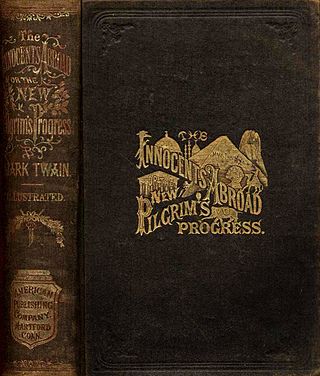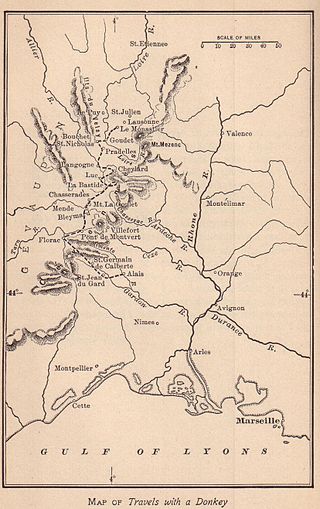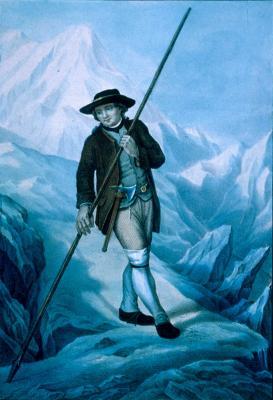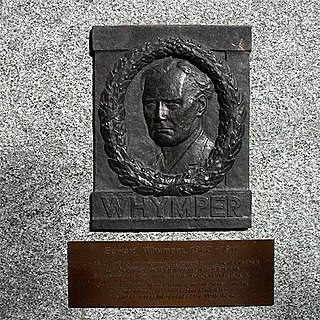
Samuel Langhorne Clemens, known by his pen name Mark Twain, was an American writer, humorist, entrepreneur, publisher, and lecturer. He was praised as the "greatest humorist the United States has produced", and William Faulkner called him "the father of American literature". His novels include The Adventures of Tom Sawyer (1876) and its sequel, Adventures of Huckleberry Finn (1884), the latter of which has often been called the "Great American Novel". Twain also wrote A Connecticut Yankee in King Arthur's Court (1889) and Pudd'nhead Wilson (1894), and co-wrote The Gilded Age: A Tale of Today (1873) with Charles Dudley Warner.

The Matterhorn is a mountain of the Alps, straddling the main watershed and border between Switzerland and Italy. It is a large, near-symmetric pyramidal peak in the extended Monte Rosa area of the Pennine Alps, whose summit is 4,478 metres (14,692 ft) high, making it one of the highest summits in the Alps and Europe. The four steep faces, rising above the surrounding glaciers, face the four compass points and are split by the Hörnli, Furggen, Leone/Lion, and Zmutt ridges. The mountain overlooks the Swiss town of Zermatt, in the canton of Valais, to the northeast; and the Italian town of Breuil-Cervinia in the Aosta Valley to the south. Just east of the Matterhorn is Theodul Pass, the main passage between the two valleys on its north and south sides, which has been a trade route since the Roman Era.

Edward Whymper FRSE was an English mountaineer, explorer, illustrator, and author best known for the first ascent of the Matterhorn in 1865. Four members of his climbing party were killed during the descent. Whymper also made important first ascents on the Mont Blanc massif and in the Pennine Alps, Chimborazo in South America, and the Canadian Rockies. His exploration of Greenland contributed an important advance to Arctic exploration. Whymper wrote several books on mountaineering, including Scrambles Amongst the Alps.

The Innocents Abroad, or The New Pilgrims' Progress is a travel book by American author Mark Twain. Published in 1869, it humorously chronicles what Twain called his "Great Pleasure Excursion" on board the chartered vessel Quaker City through Europe and the Holy Land with a group of American travelers in 1867.

The Heidelberg Tun, or Great Heidelberg Tun, is an extremely large wine vat contained within the cellars of Heidelberg Castle. There have been four such barrels in the history of Heidelberg. In 1751, the year of its construction, the present one had a capacity of 221,726 litres. Due to the drying of the wood its current capacity is 219,000 litres. One hundred and thirty oak trees were reputedly used in its construction. It has only rarely been used as a wine barrel, and in fact presently enjoys more use as a tourist attraction, and also as a dance floor since one was constructed on top of the tun.

The Barre des Écrins is a mountain in the French Alps with a peak elevation of 4,102 metres (13,458 ft). It is the highest peak of the Massif des Écrins and the Dauphiné Alps and the most southerly alpine peak in Europe that is higher than 4,000 metres. It is the only 4,000-metre mountain in France that lies outside the Mont Blanc Massif. Before the annexation of Savoy in 1860 it was the highest mountain in France.

Outdoor literature is a literature genre about or involving the outdoors. Outdoor literature encompasses several different subgenres including exploration literature, adventure literature, mountain literature and nature writing. Another subgenre is the guide book, an early example of which was Thomas West's guide to the Lake District published in 1778. The genres can include activities such as exploration, survival, sailing, hiking, mountaineering, whitewater boating, geocaching or kayaking, or writing about nature and the environment. Travel literature is similar to outdoor literature but differs in that it does not always deal with the out-of-doors, but there is a considerable overlap between these genres, in particular with regard to long journeys.

Reverend Joseph Hopkins Twichell was a writer and Congregational minister from Hartford, Connecticut. He was a close friend of writer Mark Twain for over forty years and is believed to be the model for the character "Harris" in A Tramp Abroad.

Douglas Robert Hadow was a British novice mountaineer who died on the descent after the first ascent of the Matterhorn.

Father Goose: His Book is a collection of nonsense poetry for children, written by L. Frank Baum and illustrated by W. W. Denslow, and first published in 1899. Though generally neglected a century later, the book was a groundbreaking sensation in its own era; "once America's best-selling children's book and L. Frank Baum's first success," Father Goose laid a foundation for the writing career that soon led to The Wonderful Wizard of Oz and all of Baum's later work.
"The Awful German Language" is an 1880 essay by Mark Twain published as Appendix D in A Tramp Abroad. The essay is a humorous exploration of the frustrations a native speaker of English has with learning German as a second language.

An alpenstock is a long wooden pole with an iron spike tip, used by shepherds for travel on snowfields and glaciers in the Alps since the Middle Ages. It is the antecedent of the modern ice axe.

The first ascent of the Matterhorn was a mountaineering expedition made by Edward Whymper, Lord Francis Douglas, Charles Hudson, Douglas Hadow, Michel Croz, and two Zermatt guides, Peter Taugwalder and his son of the same name, on 14 July 1865. Douglas, Hudson, Hadow and Croz were killed on the descent when Hadow slipped and pulled the other three with him down the north face. Whymper and the Taugwalder guides, who survived, were later accused of having cut the rope below to ensure that they were not dragged down with the others, but the subsequent inquiry found no evidence of this and they were acquitted.

Dilsberg Castle is a ruined castle located in Neckargemünd, Germany. It was built by the counts of Lauffen in the 12th century, but in the 14th century became part of the Electorate of the Palatinate. The castle became an administrative center for the Electoral Palatinate and thus a target in the wars of the 17th and 18th centuries. In the 19th century, the castle fell into ruin and was used as a quarry. American writer Mark Twain visited the castle in the 1870s and wrote about it in A Tramp Abroad. As of 2020, Dilsberg Castle is administered by the heritage agency Staatliche Schlösser und Gärten Baden-Württemberg.

Samuel Langhorne Clemens , well known by his pen name Mark Twain, was an American author and humorist. Twain is noted for his novels Adventures of Huckleberry Finn (1884), which has been called the "Great American Novel," and The Adventures of Tom Sawyer (1876). He also wrote poetry, short stories, essays, and non-fiction. His big break was "The Celebrated Jumping Frog of Calaveras County" (1867).
Thomas Woodbine Hinchliff was an English mountaineer, traveller, and author, from 1875 to 1877 the seventh President of the Alpine Club.

The Corps Saxo-Borussia Heidelberg is a German Student Corps at the University of Heidelberg.

A Whymper tent is a ridge tent of A-frame construction used for mountaineering which was designed by English mountaineer Edward Whymper (1840–1911) and named after him. Whymper was the first person to ascend the Matterhorn. Tents using his general design were in common use from the later part of the nineteenth century to the mid-twentieth century and were referred to generically as "Whymper tents". A later smaller variant of the design was called the Meade tent.
Truman W. "True" Williams was an American artist known as the most prolific illustrator to Mark Twain's books and novels. He illustrated the first edition of The Adventures of Tom Sawyer (1876) and was thus the first to visually portray such characters as Tom Sawyer and Huckleberry Finn. He was also sole illustrator of Twain's Sketches, New and Old and primary illustrator of Roughing It and The Innocents Abroad. Working with a number of publishers he also illustrated works by writers Bill Nye, George W. Peck, Joaquin Miller, and others. He was also a notorious drunk, which slowed his work and made him unreliable.
Charles Neider was an American writer, known for editing the Autobiography of Mark Twain and authoring literary impressions of Antarctica.






















